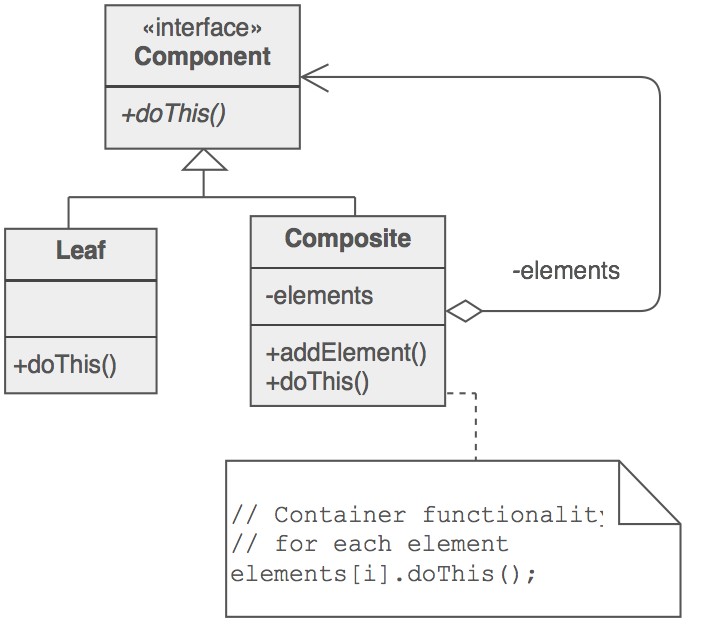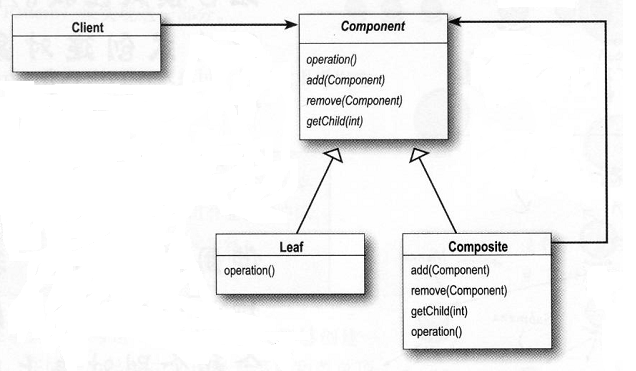个人理解:
Composite 组合模式:结构型模式
意图:
The intent of this pattern is to compose objects into tree structures to represent part-whole hierarchies.
Composite lets clients treat individual objects and compositions of objects uniformly.
允许你将对象组合成树形来表达结构来表现“整体/部分”层次结构。组合能让用户以一致的方式处理个别对象及对象组合。
包含其他组件的组件为组合对象;不包含其他组件的组件为叶节点对象。
概述:
组合模式(Composite Pattern)有时候又叫做部分-整体模式,它使我们树型结构的问题中,模糊了简单元素和复杂元素的概念 ,客户程序可以向处理简单元素一样来处理复杂元素,从而使得客户程序与复杂元素的内部结构解耦。组合模式让你可以优化处理递归或分级数据结构。
1、Component类:组合中的对象声明接口,在适当情况下,实现所有类共有接口的行为。声明一个接口用于访问和管理Component的子部件
2、Leaf类:叶节点对象,叶节点没有子节点。由于叶节点不能增加分支和树叶,所以叶节点的Add和Remove没有实际意义。有叶节点行为,用来存储叶节点集合.
3、Composite类:实现Componet的相关操作,比如Add和Remove操作。
4、children:用来存储叶节点集合
模式的应用场景:
引用大话设计模式的片段:“当发现需求中是体现部分与整体层次结构时,以及你希望用户可以忽略组合对象与单个对象的不同,统一地使用组合结构中的所有对象时,就应该考虑组合模式了。”
结构图:


模式的优缺点:
1、定义了包含基本对象和组合对象的类层次结构,基本对象可以被组合成更复杂的组合对象,而这个组合对象有可以被组合。
2、简化客户代码,客户可以一直地使用组合结构和单个对象,通常用户不知道处理的是一个叶节点还是一个组合组件。
3、使得更容易增加新类型的组件, 新定义的Composite或leaf子类自动地与已有的结构和客户代码一起工作,客户程序不需要因为新的Component类而改变。
4、使你的设计变得更一般化。
组合模式为了保持”透明性“,常常会违反单一责任原则。也就是说,它一方面要管理内部对象,另一方面要提供一套访问接口
当组合模式接口里提供删除子节点的方法时,在组件里有一个指向父节点的指针的话,实现删除操作会比较容易。
应用实例:
在GUI里,我们常会发现一个顶层的组件(例如Frame、Panel)会包含其他组件(例如menu、checkbox、scrollbar),但是操作往往是同一套接口。在Android的View体系结构里就是这样,View其实就是Component,checkbox是Leaf,ViewGroup是Composite。
代码(其实读UML图要比代码还要一目了然)
/**
* 组件的接口
*/
public abstract class FileComponent {
public void add(FileComponent component){
throw new UnsupportedOperationException();
}
public void remove(FileComponent component){
throw new UnsupportedOperationException();
}
public FileComponent getChild(int index){
throw new UnsupportedOperationException();
}
public String getName(){
throw new UnsupportedOperationException();
}
public String getDescription(){
throw new UnsupportedOperationException();
}
}
/**
* 组合件的组件,可以包含组件或者叶节点
* @author sky
*
*/
public class FileComposite extends FileComponent {
private String name;
private List<FileComponent> list;
public FileComposite(String name){
this.name = name;
list = new ArrayList<>();
}
@Override
public void add(FileComponent component) {
list.add(component);
}
@Override
public void remove(FileComponent component) {
list.remove(component);
}
@Override
public FileComponent getChild(int index) {
if ( index>=0&&list.size()>index ) {
return list.get(index);
}
return null;
}
@Override
public String getName() {
return name;
}
@Override
public String getDescription() {
Iterator<FileComponent> iterator = list.iterator();
StringBuffer sb = new StringBuffer();
sb.append(name).append(":【");
while (iterator.hasNext()) {
sb.append(iterator.next().getDescription());
}
sb.append("】");
return sb.toString();
}
}
/**
* leaf叶节点
* @author sky
*
*/
public class FileLeaf extends FileComponent {
private String name;
public FileLeaf(String name){
this.name = name;
}
@Override
public String getName() {
return name;
}
@Override
public String getDescription() {
return " name:"+name;
}
}
/**
* 测试代码
* @author sky
*
*/
public class Test {
public static void main(String[] args) {
FileComponent directory = new FileComposite("目录1");
FileComponent directory2 = new FileComposite("目录2");
FileComponent file = new FileLeaf("book");
directory2.add(file);
file = new FileLeaf("mp3");
directory2.add(file);
directory.add(directory2);
System.out.println(directory.getDescription());
}
}
<span style="font-family:Microsoft YaHei;">//</span>输出:
// 目录1:【目录2:【 name:book name:mp3】】 所有模式:
创建型模式,共五种:工厂方法模式、抽象工厂模式、单例模式、建造者模式、原型模式。
结构型模式,共七种:适配器模式、装饰器模式、代理模式、外观模式、桥接模式、组合模式、享元模式。
行为型模式,共十一种:策略模式、模板方法模式、观察者模式、迭代子模式、责任链模式、命令模式、备忘录模式、状态模式、访问者模式、中介者模式、解释器模式。
补充模式:空对象模式
参考/转自:
http://blog.csdn.net/lansuiyun/article/details/11910555
http://blog.csdn.net/imyfriend/article/details/8714164
http://blog.csdn.net/xsxxxsxx/article/details/7218221
http://blog.csdn.net/jason0539/article/details/22642281
转载请注明:http://blog.csdn.net/paincupid/article/details/44178215





















 233
233

 被折叠的 条评论
为什么被折叠?
被折叠的 条评论
为什么被折叠?








